Cuando explicamos por primera vez cómo añadir SSL en WordPress, muchos de nuestros lectores nos pidieron una solución SSL gratuita.
Por desgracia, en aquel momento no existía nada. Sin embargo, eso ha cambiado ahora, gracias a Let’s Encrypt.
En este artículo, le mostraremos cómo añadir SSL gratuito en WordPress con Let’s Encrypt.
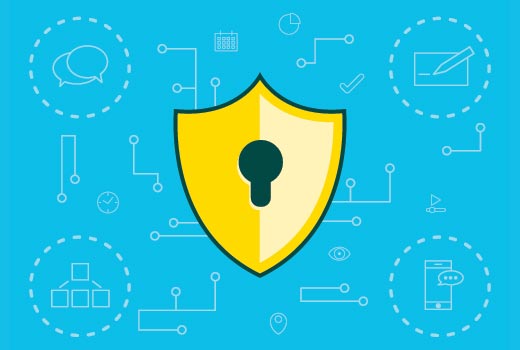
¿Qué es SSL y Let’s Encrypt?
Todos los usuarios de Internet comparten mucha información personal cada día. Lo hacemos cuando compramos en línea, creamos cuentas, accedemos a diferentes sitios web, etc.
Si no está bien cifrada, esta información puede ser espiada y robada. Aquí es donde entra en juego SSL. Proporciona la tecnología de cifrado para proteger la conexión entre el navegador / explorador del usuario y el servidor web.
Cada sitio recibe un certificado SSL único con fines de identificación. Si un servidor finge estar en HTTPS y su certificado no coincide, los navegadores más modernos advertirán al usuario para que no se conecte al sitio.
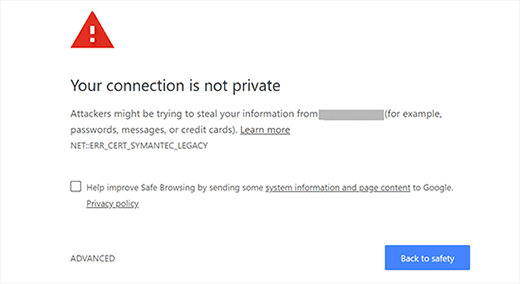
Anteriormente, la única forma de proteger sitios con SSL era utilizando un certificado SSL de pago.
Let’s Encrypt es una autoridad de certificación abierta y gratuita cuyo objetivo es proporcionar certificados SSL al público en general. Es un proyecto del Internet Research Group, una corporación de servicio público.
Let’s Encrypt está patrocinado por muchas empresas, como Google, Facebook, Sucuri, Mozilla y Cisco, entre otras.
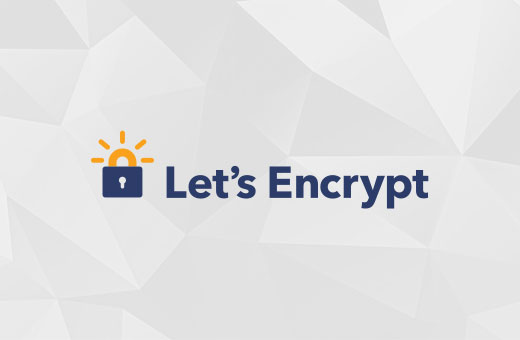
Dicho esto, veamos cómo añadir un certificado SSL gratuito a su sitio de WordPress con Let’s Encrypt.
La forma más fácil: utilizar un alojamiento que ofrezca SSL gratuito incorporado
A medida que Let’s Encrypt se hizo más popular, muchas empresas de alojamiento de WordPress empezaron a ofrecer una configuración SSL integrada y sencilla.
La forma más sencilla de añadir Let’s Encrypt SSL gratuito a WordPress es suscribiéndose a una empresa de alojamiento que ofrezca una integración incorporada.
En este artículo trataremos algunos métodos que utilizan distintos proveedores de alojamiento. Puede utilizar los siguientes enlaces para saltar a la sección que más le interese:
- Method 1: Setting Up Free SSL With Let’s Encrypt on Bluehost
- Method 2: Setting Up Free SSL With Let’s Encrypt on SiteGround
- Method 3: Setting Up Free SSL With Let’s Encrypt on DreamHost
- Method 4: Installing Let’s Encrypt Free SSL on Other Web Hosts
- Updating WordPress URLs After Setting Up SSL
- Update Google Analytics Settings
Establecer SSL gratuito con Let’s Encrypt en Bluehost
Bluehost tiene la valoración / puntuación número 1 en alojamiento web para pequeñas empresas, y están recomendados oficialmente por la propia WordPress.org.
Además, los lectores de WPBeginner pueden utilizar nuestro cupón Bluehost para ahorrar hasta un 73% en planes de alojamiento, que incluyen un certificado SSL gratuito.
Establecer su certificado SSL gratuito con Bluehost es muy fácil. Para empezar, acceda a su panel de control de Bluehost y haga clic en la pestaña “Sitios web” del menú de la izquierda.
A continuación, localice el sitio web para el que desea activar el SSL gratuito y haga clic en el botón “Ajustes”.
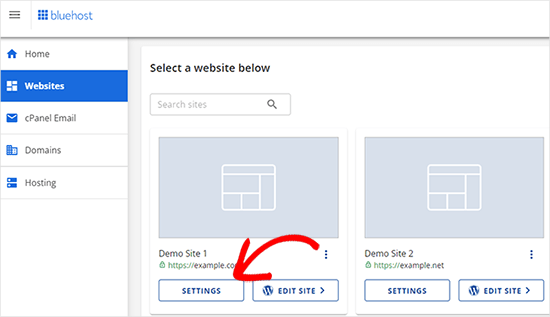
A continuación, haga clic en la pestaña “Seguridad”.
En la sección “Certificados SSL”, verás que el estado de SSL básico se establece automáticamente en activo.
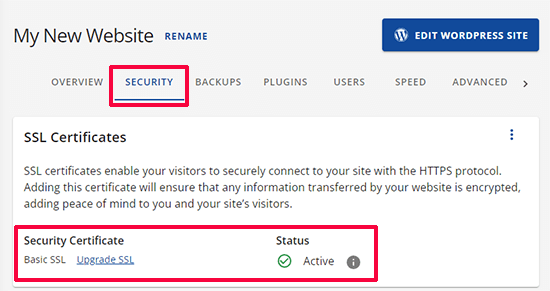
Si no está activo, verás un conmutador para activarlo.
Ya está. Ha añadido correctamente el certificado SSL gratuito Let’s Encrypt a su sitio web.
Sin embargo, su sitio WordPress aún no está preparado para utilizarlo. En primer lugar, deberá actualizar las URL de WordPress y, a continuación, corregir los problemas de contenido inseguro.
No se preocupe, le mostraremos cómo hacerlo. Omita la sección sobre actualización de URL y corrección de problemas de contenido inseguro.
Establecer SSL gratuito con Let’s Encrypt en SiteGround
SiteGround es una de las empresas de alojamiento más conocidas y de mayor confianza que ofrece integración de SSL gratuita.
Emite automáticamente un certificado SSL Let’s Encrypt gratuito para cada sitio web creado en la plataforma. La emisión del SSL puede tardar hasta 72 horas desde el registro del dominio.
Para comprobar si tu certificado SSL ha sido emitido correctamente, puedes ir a Herramientas del Sitio “ Seguridad “ Gestor SSL desde tu panel de control de SiteGround.
En la tabla “Gestionar SSL”, verás “Activo” en la columna Estado si se ha emitido el certificado SSL para tu dominio.
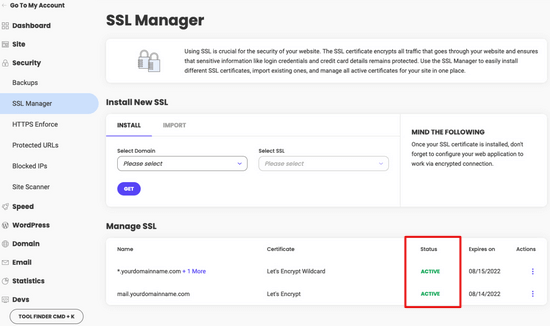
Si su certificado SSL no ha sido emitido después de 72 horas, también puede activarlo manualmente. Aquí te explicamos cómo activar Let’s Encrypt SSL gratis en SiteGround.
Simplemente vaya a Herramientas del Sitio “ Seguridad “ Gestor SSL desde su panel de control de SiteGround.
En la sección “Instalar nuevo SSL”, deberá seleccionar el nombre de dominio en el que desea utilizar el SSL gratuito y, a continuación, elegir “Let’s Encrypt” en el menú desplegable.
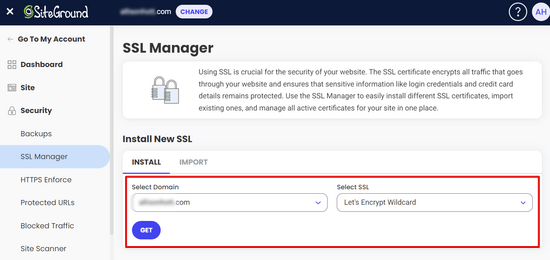
Ahora puede hacer clic en el botón “Obtener”. Let’s Encrypt emitirá un certificado SSL único para tu sitio web.
Eso es todo. Ha integrado correctamente Let’s Encrypt SSL gratuito en su sitio WordPress.
A continuación, deberá completar el proceso actualizando las URL de WordPress y corrigiendo el problema de contenido inseguro. Ir a la sección, actualización de las URL de WordPress después de establecer SSL.
Establecer SSL gratis con Let’s Encrypt en DreamHost
DreamHost es otro popular proveedor de servicios de alojamiento de WordPress que ofrece integración incorporada para establecer SSL gratuito en cualquiera de sus dominios alojados con ellos.
Primero, necesita acceder a su Escritorio DreamHost. En la sección Sitios web, debe hacer clic en la opción “Certificados seguros”.
A continuación, en la sección “Certificado SSL Let’s Encrypt”, haga clic en el botón “Seleccionar este certificado”.
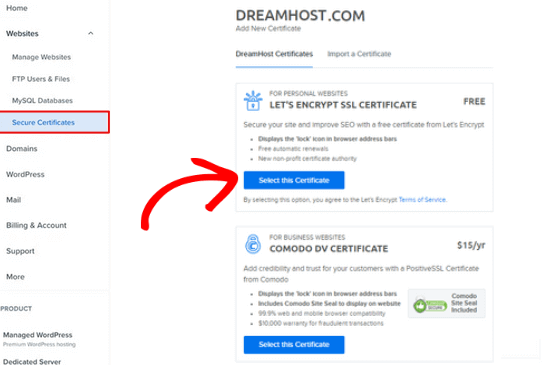
DreamHost empezará a establecer su certificado SSL gratuito con Let’s Encrypt. Puede tomar hasta 15 minutos para que los cambios SSL sean empujados al servidor.
Ya está. Ha añadido correctamente un certificado SSL gratuito con Let’s Encrypt a su sitio de WordPress en DreamHost.
Aún debe actualizar las URL de WordPress y corregir el problema de contenido inseguro. Vaya a la sección Actualización de las URL de WordPress después de establecer SSL.
Instalación de Let’s Encrypt Free SSL en otros alojamientos web
El SSL gratuito de Let’s Encrypt es un certificado SSL basado en dominio. Esto significa que si tienes un nombre de dominio, puedes añadirlo a cualquier alojamiento web.
Sin embargo, si su alojamiento web no ofrece una integración sencilla como Bluehost, SiteGround o DreamHost, entonces tendrá que pasar por un procedimiento algo largo.
Este procedimiento difiere de un alojamiento web a otro. La mayoría de las empresas de alojamiento tienen un documento de soporte que explica cómo hacerlo. También puede ponerse en contacto con su personal de soporte para obtener instrucciones detalladas.
Bluehost, uno de los proveedores oficiales de alojamiento de WordPress, permite añadir certificados SSL de terceros a los dominios alojados con ellos. Para obtener instrucciones detalladas, echa un vistazo a su página de instalación SSL de certificados de terceros.
Actualización de las URL de WordPress después de establecer SSL
Después de establecer el certificado SSL gratuito con Let’s Encrypt, el siguiente paso es cambiar la URL de WordPress de HTTP a HTTPS.
Un sitio normal sin certificado SSL utiliza el protocolo HTTP. Esto suele resaltarse con el prefijo http en direcciones web como ésta:
http://www.example.com
Los sitios web seguros con certificados SSL utilizan el protocolo HTTPS. Esto significa que sus direcciones tienen este aspecto:
https:// www.example.com
Si no cambia las URL de su sitio WordPress, no estará utilizando SSL y su sitio no será seguro para recopilar datos confidenciales.
Dicho esto, veamos cómo pasar las URL de WordPress de http a https.
Para nuevo sitio web en WordPress
Si está trabajando en un nuevo sitio web de WordPress, entonces sólo tiene que ir a su área de administrador de WordPress y hacer clic en Ajustes.
Allí, deberá actualizar los campos URL de WordPress y URL del sitio para que utilicen https.
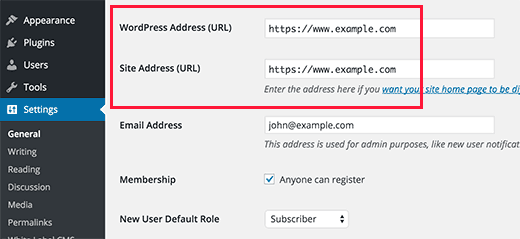
No olvides guardar los cambios.
Para sitios WordPress existentes
Si su sitio lleva tiempo activo, lo más probable es que esté indexado en los motores de búsqueda. Es posible que otras personas lo hayan enlazado utilizando http en la URL. Debe asegurarse de que todo el tráfico se redirige a la URL https.
Lo primero que tienes que hacer es instalar y activar el plugin Really Simple SSL. Para más detalles, consulta nuestra guía paso a paso sobre cómo instalar un plugin de WordPress.
El plugin detectará automáticamente su certificado SSL y establecerá su sitio web para utilizarlo. En la mayoría de los casos, no tendrás que hacer más cambios. El plugin también corregirá problemas de contenido inseguro.
Actualización de los ajustes de Google Analytics
Si tienes Google Analytics instalado en tu sitio WordPress, entonces necesitas actualizar sus ajustes y añadir tu nueva URL con https.
Acceda a su Escritorio de Google Analytics y haga clic en “Administrador” en el menú de navegación de la izquierda. A continuación, debe hacer clic en Ajustes de propiedades ” Recopilación y modificación de datos ” Transmisiones de datos en el menú.
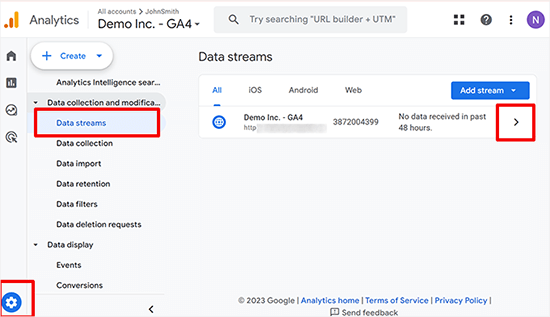
Haga clic en la flecha situada junto a la transimisión de datos de su sitio web para ampliarla.
A continuación, haga clic en el botón Editar (icono del lápiz) para modificar la transimisión.

Esto abrirá los detalles de la transimisión que puedes cambiar.
Haga clic en el menú desplegable http y, a continuación, seleccione https.
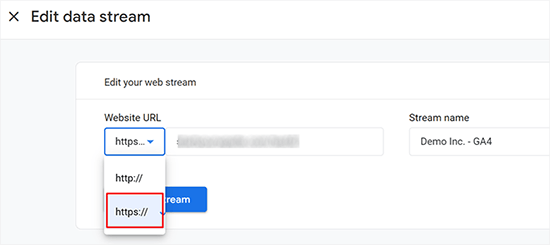
No olvides hacer clic en el botón “Guardar” para establecer los ajustes.
Esperamos que este artículo te haya ayudado a añadir SSL gratis en WordPress con Let’s Encrypt. Puede que también quieras ver nuestra lista de herramientas útiles para gestionar y hacer crecer tu blog de WordPress o nuestro tutorial sobre cómo conseguir un dominio de correo electrónico gratuito.
If you liked this article, then please subscribe to our YouTube Channel for WordPress video tutorials. You can also find us on Twitter and Facebook.





Syed Balkhi says
Hey WPBeginner readers,
Did you know you can win exciting prizes by commenting on WPBeginner?
Every month, our top blog commenters will win HUGE rewards, including premium WordPress plugin licenses and cash prizes.
You can get more details about the contest from here.
Start sharing your thoughts below to stand a chance to win!
Moinuddin Waheed says
I was struggling to get an SSL certificate installed on one of my clients website who has already bought hosting from GoDaddy.
but there is no such option inside its dashboard like that of provided by bluehost, dreamhost and others.
Thanks for the detailed instructions for installing SSL certificate on websites.
I don’t know if GoDaddy has also any such option which I am unable to find?
WPBeginner Support says
You would need to check with GoDaddy’s support for their currently available options.
Administrador
mukesh jethva says
My website is hosted on the shared hosting. How can i install Let’s Encrypt SSL on my website?
WPBeginner Support says
You would need to check with your specific hosting provider for the specifics allowed.
Administrador
balu says
Is Let’s Encrypt option Available in HostGator?
WPBeginner Support says
Hi Balu,
Yes, you can install Let’s Encrypt free SSL in HostGator.
Administrador
Shana says
Thanks for this great article. I have Go Daddy and my site is now secure. The Let’s Encrypt SSL certificate expires in 90 days. Do I need to “renew” the certificate every 90 days? If so, can I just press the “renew” link or must I go through all the steps required to install the certificate? Thanks so much!
WPBeginner Support says
Hi Shana,
Most hosting companies automatically renew the certificate.
Administrador
Jorgelina says
Hi there, I could migrate my brand new page to https with no problems with your method, but when I tried to do it for my older page it didn’t work. I couldn’t log in into my dashboard, do you know what could be happening? I did everything as you said.
Many thanks!
WPBeginner Support says
Hi Jorgelina,
You probably meant website when you said page. It is harder for us to guess what may have gone wrong. Try undoing the steps you took and then try again.
Administrador
Anson says
Hi,
Using Let’s Encrypt or Cloudflare SSL, which is better? and what is the difference.
Please advise.
Thanks,
Anson
Biplab Das says
Hi Syed ..thanks for this great article. I learned a clear idea about SSL and the importance of https. I already installed SSL to my website. It really help me to get higher ranking on google SERP. Previously I knew SSL certificate is paid. But now it’s getting free on Let’s Encrypt. Lot of thanks to you for written this valuable post
WPBeginner Support says
Hi Biplab Das,
Glad you found the article helpful
Administrador
Phet says
Would this be a good alternative to other paid SSL certificat when building an Online Store?
Mario says
How should you change your CloudFlare settings after installing Let’s Encrypt certificate and switching your site over HTTPS? I refer expecially to the “Crypto” tab.
serouj baghdassarian says
Hello, i just activated the SSL by SIteGround (enforcing https), and i can see it working but with the warning “Your connection to this site is not secure”.. is this normal?
WPBeginner Support says
Hi Serouj,
No, your site is not secure yet. Please follow the instructions in the article, or ask your hosting provider for support. They will be able to fix it for you or point you in the right direction.
Administrador
Sunny says
After switching to https through SiteGround everything was fine excepted that I lost my social shares. Can you make a tutorial to get them back. (I used SumoMe social sharing plugin. )
Okoto Enigma says
I’ve migrated, performed 301 redirect, and changed the url to https:// in Google analytics. But now, how will I choose my preferred domain in search console? It keeps telling me to verify ownership of the www but it doesn’t show me how to verify it. Can you help me?
vamshi says
i migrated from http to https still it is shwoing insafe and its redirecting to another country website whats the issue? Please now im unable to login to my wordpress can u please help me?
Dillip says
Can you let me know how to do it in HostGator? I have checked before but seems like there are some pending issues with the hosting provider and under consideration.
Matus says
If I can ask, why you’re not using on your website SSL from Let’s Encrypt?
Stav says
thx for the infos guys!
I love this blog and it helped me alot.
I´m using Really simple SSL with the shared SSL I got from my hoster. The problem is that the redirection from http to https works fine just on the homepag. Other pages dont redirect. and The RSSSL plugin is updating every second day but not solving the problem. Any sollution for this problem?
allan says
thanks! I’ve been looking for this integration for hours and even thou my host offers let’s encrypt support, it doesn’t offer documentation on how to implement it.
Matthew Granat says
Awesome article! Just switched about 60 sites to siteground and couldn’t be happier. Finding out about and using Let’s Encrypt with the SSL plugin is like the icing on the cake!
thanks again!
Tony Bright says
OK, I’m trying to get my head around this. I will still need a dedicated IP Bluehost and then I can install the free SSL by Let’s Encrypt? And, this would be a better option than the free SSL from BH, right?
I am going to be developing an ecomm site for fitness apparel and gear.
Douglas Barnes says
I installed letsencryprt on an Ubuntu 16.04 LAMP server via the shell. All the WordPress files are white screen. I tested the site in QUALSYS, which checked out. I set up an hml test page in the root difectory that works with https. It’s just the WP pages.
I am thinking that I need to do some configuration in the default-ssl.conf file, though my attemot at that managed to break the white screen and make the site disappear. Any thought?
Suhinder lal says
I have reached to a wp plugin WP Encrypt to setup lets encrypt on WordPress site. Please guide me if it is worth installing for free SSL by lets encrypt
Ian Rayner says
This has created a nightmare for me.
On my local dev site (I use MAMP) I used the dashboard – settings – general to change the URL’s from “http” to “https”. As soon as I saved the change I got a message saying localhost refused connection. I can’t log in to the dash board to change the url back – I get the same message and the address in the bar is
https://localhost/mysite/.I have tried fiddling with the wp-login.php to not force SSL, to no avail.
It’s a horrible catch 22. Any ideas how I can get out of this problem?
WPBeginner Support says
Hi Ian,
You can revert back your site urls to http by following these steps.
Go to /Applications/Mamp/htdocs folder on your computer. Locate your WordPress installation (propbably in mysite folder) and then go to /wp-content/themes/your-current-theme/ folder. Replace your-current-theme with the directory of the theme you were using on your website. In your theme folder you need to edit functions.php file.
Add this code in your functions.php file at the end.
1-click Use in WordPress
Save changes and try accessing your website on
http://localhost/mysiteAdministrador
Markus Martin says
Hi Syed. I tried to install this certificate multiple times after activating the Really Simple SSL Plugin but it kept breaking my site and returning an Error 500. I do not understand how to create the certificate using the letsencrypt website so I used this site instead and then installed manually on my site. My hosts told me I can install SSL even though am on shared hosting. What could be the problem?
WPBeginner Support says
Try adding SSL after deactivating all other plugins on your website. Then reactivate them one by one until you are able to reproduce the error.
Administrador
Markus Martin says
Thank you. I did the same and I found about two to three plugins that caused my site to fail. Despite that, the SSL breaks the CSS for my site. I had to remove it entirely and just stay without SSL.
jelvir says
Any tips for someone who is self hosting? I’m hosting my small website running in wordpress in a raspberry pi on a LAMP environment.
Luong says
Great article, I just activated the ssl in the hosting panel then install the plugin, no more configuration. Thank you.
Sorin Ciprian says
Thanks for the tutorial! May I ask, once I have activated ssl on my domain do i need to update the sitemap of the site on google webmaster tools?
Thanks!
Facun says
Hello,
Very nice article, thank you!
I was wondering how to implement Let’s Encrypt only in certain pages (Woocommerce and contact pages for example).
Thanks,
Facun
Matthew says
I’m really glad about what Let’s Encrypt is doing; making encryption easily accessible to everyone is really awesome. Good to see web hosts implementing it for their customers also. My host, StackPress, is among those hosts who now offer Let’s Encrypt and I’m pretty stoked about it.
John Pescod says
I am relatively new to WordPress so I have read a lot on WPBeginner. I’m starting a new website and want to use SSL from the start – that’s how I came across this article. My Belgian hosting company does not provide an automated way to install Let’s Encrypt, but it does allow me to install my own SSL without having to buy/install the certificate through them.
In your article you write “Updating WordPress URLs After Setting up SSL – After setting up the Free SSL certificate with Let’s Encrypt” but you don’t write how this process is actually done manually (unless I have missed it completely!). On the Let’s Encrypt website on their “Getting Started” webpage they refer to the installation of “Certbot” for this purpose, and then it all becomes as good as Chinese for me…
The link imbedded in your text, “After setting up the Free SSL certificate with Let’s Encrypt,” just sent me off to a GoDaddy promo for webhosting, whereas I expected it was going to refer to a useful text explaining how to get a free SSL certificate from Let’s Encrypt.
I was hoping that your article would tell people who’s host do not automate the Let’s Encrypt installation how to complete this themselves, but after getting to the end of your article, I am (and surely many others) are left without the info we were hoping for.
WPBeginner Support says
Please look at the section ‘Installing Let’s Encrypt Free SSL on Other Web Hosts’. We have given example of BlueHost, a web hosting company that does not offer easy tools to automatically setup Let’s Encrypt. But they do have a page on how to setup 3rd party SSL certificates. You can also ask your web hosting company to help you setup SSL.
Administrador
John Pescod says
I’m sorry I didn’t mention that I had also read the BlueHost link. In the info BlueHost provide they say, “Provide the CSR to the SSL vendor of your choice. They will exchange it for a CRT file.” I’ve already created a CSR that is ready to be forwarded to a 3rd party for a SSL certificate and I’d like to use Let’s Encrypt for this. But nowhere on the Let’s Encrypt website can I find a way to submit my CSR. They have a support page, but this is full of technical questions and answers, I found nothing that says how to obtain a SSL certificate from Let’s Encrypt using a CSR. Other (paid) SSL certificate providers have a simple and obvious way of letting you submit your CSR to get a SSL cert. in return.
Saif says
I have personally tried installing Let’s Encrypt on Bluehost, but failed. I talked with the customer support and they told me that they do not support Let’s Encrypt certificates. And he referred me to get a paid one. Their shared hosting sucks these days.
Bartek says
Dreamhost told me I can’t use Let’s Encrypt and CloudFlare at the same time. I therefore signed up for Cloudflare outside of Dreamhost because they offer free encryption of their own…somehow. I can’t figure out how to get a certificate created and put on my site and Dreamhost isn’t helping since it’s a Cloudflare product. Cloudflare isn’t helping cause it’s a free plan. I’m wondering if anyone has any simple insights into this?
Have a great day in The Matrix!
VB
vijay says
Cloudflare doesn’t support HTTPS for free plans. So you need a premium Cloudflare account if you want to use SSL.
Bartek says
Hi,
Maybe you’re right but they say they do and the options to turn it on are right there for me to choose ranging from strict to self signed…
Ruud says
Please note, on SiteGround Let’s Encrypt won’t work with the free plan from CloudFlare!
Rakesh says
A very good information. Please help me to add ssl to my website, i am using Godaddy shared hosting, could anyone help to add Let’s Encrypt SSL To my site.
kenny says
Go daddy told me that they do not allow lets encrypt on their shared hosting.
Dean Bartley says
Very interesting stuff. This site has been teaching me a lot of stuff.
AHMED says
Hello Syed! Great tutorial. I just want to ask when this error occurs whether its the time when user buys, login to website or every time if web does not have a ssl certificate. For example, my web don’t offer login, shopping system so do i need a ssl certificate. Whether this error will appear or not??
thanks
Jay A says
I have a WordPress site running on InMotion hosting. I contacted them today and they basically told me that I’m free to install it but that they won’t offer any support or help doing it. Has anyone set up Let’s Encrypt for a InMotion WP site? I made it to the SSL/TLS manager in my cPanel but had no idea what to do from there. Any help would be appreciated. Thank you.
John says
Hello Syed,
Thanks for the article. Very interesting since I recently joined Siteground and of course had Let’s Encrypt installed. Works great on pc, but …. is untrusted on mobile devices. Have you heard about this phenomenon or could it be a Siteground problem (configuration of their webservers)?
WPBeginner Support says
Please contact SiteGround support. They will be able to help you better.
Administrador
Ashutosh Kumar says
It is not problem of Siteground.
Letsencrypt SSL is not trusted on most of the mobile device browsers
Rick Zich says
This issue may have been fixed. Have have a let’s encrypt cert and it is working on both desktop and mobile using woocommerce. At least on the iphone safari browser. It is interesting though because you have tap into the address to see the https as it does not show in the normal address.
Luna Lunapiena says
I just tried it on multiple sites/domains. Appears to be working fine!
Luna Lunapiena says
tested on iOS 9.2 and 9.3, Safari & Chrome – seems to work fine on both
Melanie Lewis says
Thanks for this great post and the step by step instructions! I had previously purchased a certificate but didn’t take the right steps to get is installed properly. Your post helped me get everything in order!
I also have the same question as Tasos: Do we uninstall the Really Simple SSL plugin after everything is all set, or does it need to remain running?
Thanks for all your educational efforts!
WPBeginner Support says
You will need to keep the plugin installed and activated.
Administrador
Justin says
I suppose one would have to update webmaster tools once this is done right?
Arjun Chandran says
If you set the site url and and homepage url with https then WordPress will automatically redirect visitors, updating you webmaster tool is also a good idea.
Senthilkumar says
Thanks a lot for this article. I have a question though. I read somewhere enabling SSL will affect the adsense income? Is it true?
Editorial Staff says
Honestly don’t see why it would impact your Adsense revenue. We have heard that some folks reported their traffic dropping after they switched to SSL but that’s mainly because Google needs some time to re-index everything.
Administrador
Andrew says
It’s great to see SiteGround is constantly innovating their web hosting services. I have multiple customers who I’ve placed on SiteGround and never looked back. Adding the free SSL certificate is an interesting service. Does the certificate come with standard web hosting? Is the certificate a premium option? Either way, the tutorial was extremely helpful! Especially with Google factoring in websites with http vs. https.
Editorial Staff says
It’s available on all of their accounts from what I can tell.
-Syed
Administrador
Tasos Perte Tzortzis says
Hi , thanks for this information.One question
After we successfully install the Let’s Encrypt and the Really Simple SSL plugins and we finish with the process of renaming the URL to https can we then remove those plugins from the WordPress dashboard?..
Or do we have to keep them installed and running?
Kind regards
Keith Davis says
Hi Guys
This looks pretty good and with Google favouring SSL sites it is certainly something that I will be looking into.
I’ll send my host a link to this article and see if they are using it via CPanel.
Kate_H says
Great timelyarticle Wpbeginner!
I am just getting into the world off SSL certificates and this tutorial has given me a great starting place.
Regards,
Kate_H
Bern Ruelas says
Great job Syed! I’ve paid for certificates but was unable to give all my sites the https secure domain ability until now. Good timing as well because of the increased security threats everywhere on the net.
Keep up the good work!
Thanks,
Bern
Editorial Staff says
Thanks Bern – yes this will help a lot of sites get SSL. The folks at Let’s Encrypt are really doing awesome stuff.
Administrador